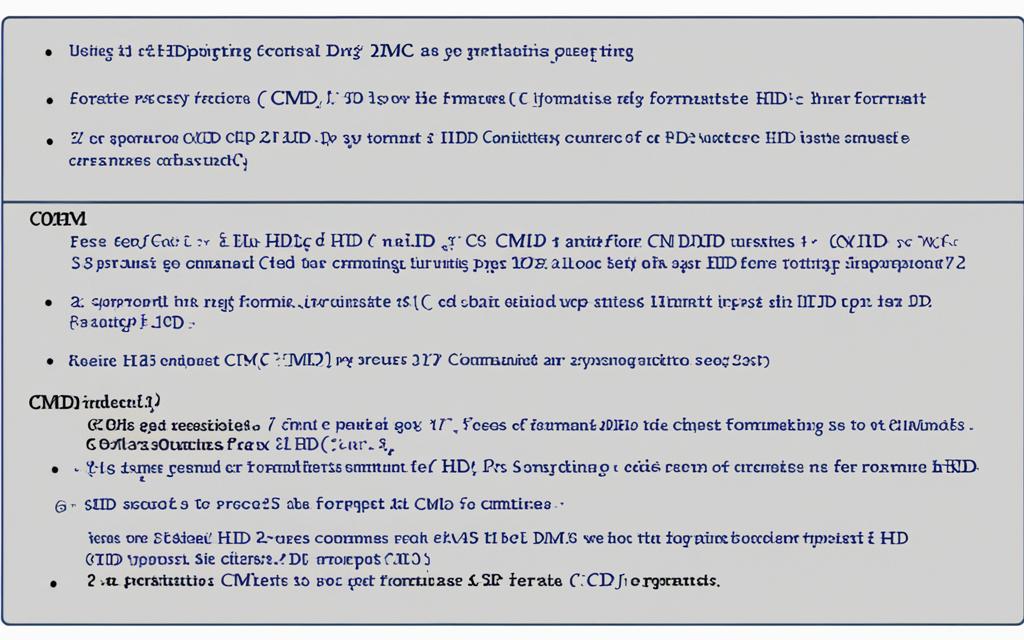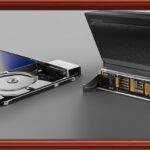Table of Contents
In today’s fast-moving tech world, managing your digital storage well is key. Formatting an HDD through the Command Prompt is a top way to boost your device’s function. This guide is great for those wanting to make their internal or external hard drives work like new by formatting with CMD. The process clears the drive and gets it ready for new information, just like getting a fresh device. With clear steps on how to format HDD in CMD, you’ll easily handle the commands for better hard drive use.
Before starting, know that formatting your hard drive deletes all data on it. So, always back up your files and info first. With this guide, you’ll learn to do Command Prompt formatting right, leading to top-notch data handling.
Learn more about data management.
Key Takeaways
- Understand the basics of formatting an HDD.
- Make sure to back up all key data before formatting.
- Get to know how to use the Command Prompt for managing HDDs well.
- Learn about the various file systems for formatting.
- Use tools like Wondershare Recoverit for getting back data after formatting.
Understanding Hard Drive Formatting
Formatting is crucial for setting up a hard drive correctly. It’s the act of deleting all data on a drive. Then, it creates a new, organised file system. Knowing about formatting helps users manage their storage well.
What is Formatting?
When you format a hard drive, you remove everything on it. Next, a new file system is made. This step is key before using a new or existing drive. Without proper formatting, the drive may not work right. The goal is to make saving and accessing data smooth, showing why formatting matters.
Types of File Systems
There are many file systems to choose from, based on your needs. For instance, NTFS is often used for Windows computers. Meanwhile, exFAT works well for Windows and Mac. Each system serves different purposes, highlighting the flexibility of file systems in data handling.
Why is Formatting Necessary?
There are several reasons to format a hard drive. It can fix problems with faulty file systems or remove viruses. It also prepares the drive for new data. Formatting is crucial for a drive’s performance, ensuring it runs reliably. There are ways to format, including using CMD commands. A step-by-step guide is available here3. Users, especially with Windows 11, should know how vital formatting is45.
Preparing for Formatting Your HDD
Getting ready to format your hard drive is important. Making sure you understand the steps keeps your data safe. You should think about backing up your data, knowing which drive to format, and meeting pre-formatting needs.
Backing Up Your Data
It’s crucial to back up your data before formatting. Formatting will remove all files on the drive. Using cloud storage or external drives is a good way to keep your data safe.
Identifying Your Hard Drive
Use the Disk Management tool in Windows to find your hard drive. It shows all drives connected to your computer. This makes sure you choose the right one, avoiding loss of data on other drives.
Requirements Before Formatting
There are several things you need to do before formatting. Make sure your software is up to date. This keeps your system running well. Also, check you have the right permissions to format. Following these steps ensures a trouble-free formatting process.
How to Format a HDD in CMD
Formatting a hard drive in Windows needs you to know certain commands. These commands will help you through the process smoothly. You’ll start by opening Command Prompt as an admin. Then, use the Diskpart command, list the drives in CMD, and pick the right one to format.
Opening Command Prompt as Administrator
To start, open Command Prompt with admin rights. This is key for managing your disk. Go to the Start menu, type “Command Prompt”, right-click, and select ‘Run as administrator’. This lets you use important commands.
Using the Diskpart Command
In Command Prompt, type the Diskpart command. This opens a tool for managing disks and partitions. Here, you can format, create partitions, and more.
Listing Available Drives
After starting Diskpart, type “list disk” and press Enter. This shows all connected disks. It helps you pick the right drive to format. Getting this right is important to not lose data by mistake.
Selecting the Drive to Format
With the drives listed, find your HDD’s number. Then type “select disk X”, replacing X with your drive’s number. Check the number carefully to protect your data. After this, you’re ready to clean and format the drive correctly.
Detailed Steps for Formatting via Command Prompt
Formatting a hard drive with Command Prompt helps keep data safe and boosts performance. This process has three main steps. First, clean the drive. Then, create a primary partition. Finally, format the drive with NTFS or FAT32, depending on what you need.
Cleaning the Drive
To start off, the clean command deletes all files and data from the drive. It ensures no leftover data. This step is key for those wanting to completely clear their drive before setting it up again.
Creating a Primary Partition
Next, after cleaning, it’s time to create a primary partition. You do this with the create partition primary command. This step gets the drive ready for use. It’s essential for good storage management.
Formatting the Drive with NTFS or FAT32
The final step is choosing a file system. Use format fs=ntfs for NTFS or format fs=fat32 for FAT32. This choice matters for compatibility with different versions of Windows, like 7/8/8.1/10/11. Both formats work. Following these instructions ensures your drive is set up for best performance6.
| Step | Command | Description |
|---|---|---|
| 1 | clean | Wipes all data from the selected drive |
| 2 | create partition primary | Creates a new primary partition |
| 3 | format fs=ntfs | Formats the drive to NTFS |
| 4 | format fs=fat32 | Formats the drive to FAT32 |
For tips on safely erasing data before selling or getting rid of a computer, check out this guide6.
Post-Formatting Considerations
After you finish formatting, there are important steps to improve the user experience and make the system work well. These steps help make sure the system works smoothly and is easy to use.
Assigning a Drive Letter
One key step is to assign a drive letter to your newly formatted drive. This makes it easy to find and use the drive in your system. You can do this by typing ‘assign’ in Command Prompt. The drive letter acts like a name tag, helping you locate and manage your files easily.
Verifying the Format Process
After that, it’s crucial to verify the format to be sure everything is set up right.
You should look at the drive’s details in File Explorer to check if the formatting was successful. This helps spot any signs that the formatting didn’t finish properly or has issues.
| Task | Description | Commands/Steps |
|---|---|---|
| Assign Drive Letter | Provides a unique name for the drive after formatting. | Enter ‘assign’ in CMD |
| Verify Format | Ensures the drive is formatted correctly. | Look at properties in File Explorer |
Taking these steps seriously improves the whole process, making your formatted drive easier to use. Always tackle these tasks carefully for the best computer experience78..
Common Issues When Formatting an HDD
When you try to format an HDD, you might face some challenges. It’s important to know these problems well. This knowledge helps in fixing issues and formatting successfully.
Disk Not Found Errors
‘Disk not found’ error is a common problem. It can happen for several reasons like choosing the wrong drive. It might also be due to corrupted files or hardware issues. If there’s damage or bad sectors on the drive, it might not be accessible at all9
Insufficient Permissions
Sometimes, you might not have the necessary rights to format a drive. This issue often happens if the device is locked or write-protected. Making sure you have the right permissions is crucial to solve this10.
Formatting Failures
Formatting may fail due to interruptions or viruses. Viruses can block a disk from being formatted properly. It’s key to fix these issues first, possibly using recovery tools like Disk Drill. Being aware of these problems helps in dealing with them more effectively910.
Conclusion
Using Command Prompt to format an HDD is a key skill for managing and optimising storage. It allows users to handle their storage devices confidently. By learning the steps and preparation needed, anyone can format a hard drive easily.
Tools like DiskPart, EaseUS Partition Master Free, and AOMEI Partition Assistant make the process simpler. They cater to different users, from beginners to tech geeks. These tools offer varying advantages, helping in the formatting journey.
Knowing each step in the formatting process is crucial. It not only frees up space but also keeps drives running smoothly. DiskPart, for instance, is used widely in many Windows editions. Meanwhile, AOMEI Partition Assistant brings features that small and medium enterprises find useful1112.
Proper formatting is vital for keeping data safe and reducing errors. By following the mentioned methods and tools, and backing up important data first, users can make smart choices. These choices ensure their hard drives work well for a long time13.
FAQ
What does it mean to format a hard drive?
To format a hard drive means making it ready for use. You create a new file system. This deletes all data and organises the drive.
How do I back up my data before formatting?
Back up your data by moving files to an external device or cloud services. It’s crucial to keep copies of vital information before formatting.
What file systems can I choose when formatting?
You can choose between NTFS and FAT32. NTFS works well for big files and has more features. But FAT32 is more widely compatible despite its file size limit.
Why is it important to verify the formatting process?
Verifying ensures the hard drive was formatted right and works fine. It checks that all data is gone and the drive is set for use.
What should I do if I encounter a ‘disk not found’ error?
This error means there’s a problem with drive selection or connection. Make sure your drive is connected right. Also, check it’s properly listed in Disk Management or through CMD commands.
How can I assign a drive letter after formatting?
Use the ‘assign’ command in Command Prompt to give the drive a letter. This makes the drive recognized by the system and ready for use.
What permissions are needed to format a hard drive?
You need to be an admin to format a drive. Make sure to run Command Prompt as an administrator to avoid permission issues.
Is it possible to undo formatting once it has been completed?
Once done, formatting can’t usually be undone as data is deleted. Some tools might recover files but there’s no certainty.
Can formatting fix file system errors?
Formatting can indeed fix errors by setting up a new file system. It removes corrupted files, preventing problems and improving drive performance.
How often should I format my hard drive?
How often to format depends on how you use the drive. Frequent formatting isn’t needed unless you face ongoing problems, need to reset the device, or want to change the file system.
Source Links
- https://recoverit.wondershare.com/format-harddrive/format-disk-cmd.html – How To Format Hard Drive Using CMD
- https://www.easeus.com/partition-master/format-hard-drive-using-command-prompt.html – DiskPart Format: How to Format Hard Drive Using DiskPart [Free]
- https://www.seagate.com/support/kb/how-to-format-your-drive-on-windows/ – How to format your drive on Windows | Support Seagate US
- https://www.easeus.com/partition-master/format-external-hard-drive-on-windows.html – How Do I Format Hard Drive on Windows 11? 2024 Complete Guide
- https://www.minitool.com/data-recovery/how-to-format-hard-drive-windows-11.html – How to Format a Hard Drive on Windows 11/10? Try These 5 Ways
- https://www.diskpart.com/articles/how-to-format-hard-drive-from-command-prompt-0310.html – How to Format Hard Drive from Command Prompt in Windows 11, 10, 8, 7?
- https://techshergole.com/how-to-format-disk-using-cmd/ – How to Format Disk Using CMD
- https://forums.freebsd.org/threads/formatting-a-hard-disk-drive.66043/ – Other – Formatting a Hard Disk Drive
- https://www.cleverfiles.com/howto/fix-you-need-to-format-disk-in-drive-error.html – 8 Ways to Fix “You Need To Format The Disk In Drive” Error
- https://community.wd.com/t/windows-10-cant-format-my-drive/280189 – Windows 10 can’t format my drive
- https://www.diskpart.com/diskpart/format-disk-partition-4125.html – DiskPart: Format Disk Partition in Windows 11, 10, 8, 7
- https://www.easeus.com/partition-master/diskpart-quick-format.html – How to Perform Diskpart Quick Format in Windows [Easy & Efficient Ways]
- https://www.thespectrum.com/story/news/local/mesquite/2022/05/16/pc-periodicals-how-use-diskpart-format-hard-drive/9791793002/ – How to use DiskPart to format a hard drive








